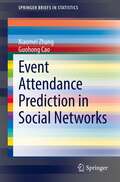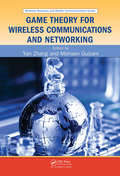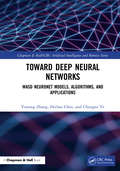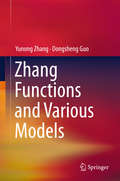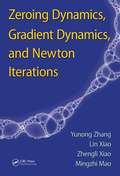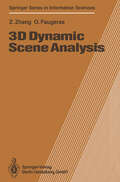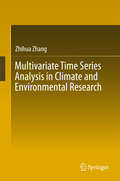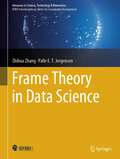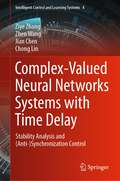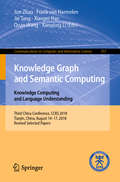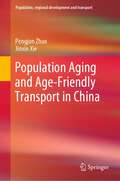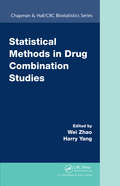- Table View
- List View
Topology Optimization of Compliant Mechanisms
by Xianmin Zhang Benliang ZhuThis book covers various topics regarding the design of compliant mechanisms using topology optimization that have attracted a great deal of attention in recent decades. After comprehensively describing state-of-the-art methods for designing compliant mechanisms, it provides a new topology optimization method for finding new flexure hinges. It then presents several attempts to obtain distributed compliant mechanisms using the topology optimization method. Further, it discusses a Jacobian-based topology optimization method for compliant parallel mechanisms, and introduces readers to the topology optimization of compliant mechanisms, taking into account geometrical nonlinearity and reliability. Providing a systematic method for topology optimization of flexure hinges, which are essential for designing compliant mechanisms, the book offers a valuable resource for all readers who are interested in designing compliant mechanism-based positioning stages. In addition, the methods for solving the de facto hinges in topology optimized compliant mechanisms will benefit all engineers seeking to design micro-electro-mechanical system (MEMS) structures.
Event Attendance Prediction in Social Networks (SpringerBriefs in Statistics)
by Xiaomei Zhang Guohong CaoThis volume focuses on predicting users’ attendance at a future event at specific time and location based on their common interests. Event attendance prediction has attracted considerable attention because of its wide range of potential applications. By predicting event attendance, events that better fit users’ interests can be recommended, and personalized location-based or topic-based services related to the events can be provided to users. Moreover, it can help event organizers estimating the event scale, identifying conflicts, and help manage resources. This book first surveys existing techniques on event attendance prediction and other related topics in event-based social networks. It then introduces a context-aware data mining approach to predict the event attendance by learning how users are likely to attend future events. Specifically, three sets of context-aware attributes are identified by analyzing users’ past activities, including semantic, temporal, and spatial attributes. This book illustrates how these attributes can be applied for event attendance prediction by incorporating them into supervised learning models, and demonstrates their effectiveness through a real-world dataset collected from event-based social networks.
Android Malware Detection and Adversarial Methods
by Xiaosong Zhang Weina Niu Ran Yan Jiacheng GongThe rise of Android malware poses a significant threat to users’ information security and privacy. Malicious software can inflict severe harm on users by employing various tactics, including deception, personal information theft, and device control. To address this issue, both academia and industry are continually engaged in research and development efforts focused on detecting and countering Android malware. This book is a comprehensive academic monograph crafted against this backdrop. The publication meticulously explores the background, methods, adversarial approaches, and future trends related to Android malware. It is organized into four parts: the overview of Android malware detection, the general Android malware detection method, the adversarial method for Android malware detection, and the future trends of Android malware detection. Within these sections, the book elucidates associated issues, principles, and highlights notable research. By engaging with this book, readers will gain not only a global perspective on Android malware detection and adversarial methods but also a detailed understanding of the taxonomy and general methods outlined in each part. The publication illustrates both the overarching model and representative academic work, facilitating a profound comprehension of Android malware detection.
Investing in China and Chinese Investment Abroad
by Xiuping Zhang Bruce P. CorrieThe book provides a study of the investment environment for international enterprises in China and overseas investment by Chinese enterprises. Applying statistical methods and up-to-date data analysis, it examines every aspect of the investment environment in China. The author’s ideas are further illustrated with 39 figures and diagrams. Its 18 chapters discuss topics ranging from history, the current situation and problems of foreign investment in China, to China’s policies for attracting foreign investment, the top 500 global companies in China, urban competitive analysis and multinational corporations in Beijing. It also analyzes Chinese investment in foreign countries. It is a valuable investment guide, and is also a useful reference resource for academic research and teaching related to international business and the Chinese economy.
Game Theory for Wireless Communications and Networking
by Yan Zhang Mohsen GuizaniUsed to explain complicated economic behavior for decades, game theory is quickly becoming a tool of choice for those serious about optimizing next generation wireless systems. Illustrating how game theory can effectively address a wide range of issues that until now remained unresolved, Game Theory for Wireless Communications and Networking provid
Geometric Modeling and Mesh Generation from Scanned Images (Chapman & Hall/CRC Mathematical and Computational Imaging Sciences Series)
by Yongjie Jessica ZhangCutting-Edge Techniques to Better Analyze and Predict Complex Physical Phenomena Geometric Modeling and Mesh Generation from Scanned Images shows how to integrate image processing, geometric modeling, and mesh generation with the finite element method (FEM) to solve problems in computational biology, medicine, materials science, and engineering. Based on the author’s recent research and course at Carnegie Mellon University, the text explains the fundamentals of medical imaging, image processing, computational geometry, mesh generation, visualization, and finite element analysis. It also explores novel and advanced applications in computational biology, medicine, materials science, and other engineering areas. One of the first to cover this emerging interdisciplinary field, the book addresses biomedical/material imaging, image processing, geometric modeling and visualization, FEM, and biomedical and engineering applications. It introduces image-mesh-simulation pipelines, reviews numerical methods used in various modules of the pipelines, and discusses several scanning techniques, including ones to probe polycrystalline materials. The book next presents the fundamentals of geometric modeling and computer graphics, geometric objects and transformations, and curves and surfaces as well as two isocontouring methods: marching cubes and dual contouring. It then describes various triangular/tetrahedral and quadrilateral/hexahedral mesh generation techniques. The book also discusses volumetric T-spline modeling for isogeometric analysis (IGA) and introduces some new developments of FEM in recent years with applications.
Geometric Modeling and Mesh Generation from Scanned Images (Chapman & Hall/CRC Mathematical and Computational Imaging Sciences Series)
by Yongjie Jessica ZhangCutting-Edge Techniques to Better Analyze and Predict Complex Physical Phenomena Geometric Modeling and Mesh Generation from Scanned Images shows how to integrate image processing, geometric modeling, and mesh generation with the finite element method (FEM) to solve problems in computational biology, medicine, materials science, and engineering. Based on the author’s recent research and course at Carnegie Mellon University, the text explains the fundamentals of medical imaging, image processing, computational geometry, mesh generation, visualization, and finite element analysis. It also explores novel and advanced applications in computational biology, medicine, materials science, and other engineering areas. One of the first to cover this emerging interdisciplinary field, the book addresses biomedical/material imaging, image processing, geometric modeling and visualization, FEM, and biomedical and engineering applications. It introduces image-mesh-simulation pipelines, reviews numerical methods used in various modules of the pipelines, and discusses several scanning techniques, including ones to probe polycrystalline materials. The book next presents the fundamentals of geometric modeling and computer graphics, geometric objects and transformations, and curves and surfaces as well as two isocontouring methods: marching cubes and dual contouring. It then describes various triangular/tetrahedral and quadrilateral/hexahedral mesh generation techniques. The book also discusses volumetric T-spline modeling for isogeometric analysis (IGA) and introduces some new developments of FEM in recent years with applications.
Deep Neural Networks: WASD Neuronet Models, Algorithms, and Applications (Chapman & Hall/CRC Artificial Intelligence and Robotics Series)
by Yunong Zhang Dechao Chen Chengxu YeToward Deep Neural Networks: WASD Neuronet Models, Algorithms, and Applications introduces the outlook and extension toward deep neural networks, with a focus on the weights-and-structure determination (WASD) algorithm. Based on the authors’ 20 years of research experience on neuronets, the book explores the models, algorithms, and applications of the WASD neuronet, and allows reader to extend the techniques in the book to solve scientific and engineering problems. The book will be of interest to engineers, senior undergraduates, postgraduates, and researchers in the fields of neuronets, computer mathematics, computer science, artificial intelligence, numerical algorithms, optimization, simulation and modeling, deep learning, and data mining. Features Focuses on neuronet models, algorithms, and applications Designs, constructs, develops, analyzes, simulates and compares various WASD neuronet models, such as single-input WASD neuronet models, two-input WASD neuronet models, three-input WASD neuronet models, and general multi-input WASD neuronet models for function data approximations Includes real-world applications, such as population prediction Provides complete mathematical foundations, such as Weierstrass approximation, Bernstein polynomial approximation, Taylor polynomial approximation, and multivariate function approximation, exploring the close integration of mathematics (i.e., function approximation theories) and computers (e.g., computer algorithms) Utilizes the authors' 20 years of research on neuronets
Zhang Functions and Various Models
by Yunong Zhang Dongsheng GuoThis book focuses on solving different types of time-varying problems. It presents various Zhang dynamics (ZD) models by defining various Zhang functions (ZFs) in real and complex domains. It then provides theoretical analyses of such ZD models and illustrates their results. It also uses simulations to substantiate their efficacy and show the feasibility of the presented ZD approach (i.e., different ZFs leading to different ZD models), which is further applied to the repetitive motion planning (RMP) of redundant robots, showing its application potential.
Zeroing Dynamics, Gradient Dynamics, and Newton Iterations
by Yunong Zhang Lin Xiao Zhengli Xiao Mingzhi MaoNeural networks and neural dynamics are powerful approaches for the online solution of mathematical problems arising in many areas of science, engineering, and business. Compared with conventional gradient neural networks that only deal with static problems of constant coefficient matrices and vectors, the authors’ new method called zeroing dynamics solves time-varying problems. Zeroing Dynamics, Gradient Dynamics, and Newton Iterations is the first book that shows how to accurately and efficiently solve time-varying problems in real-time or online using continuous- or discrete-time zeroing dynamics. The book brings together research in the developing fields of neural networks, neural dynamics, computer mathematics, numerical algorithms, time-varying computation and optimization, simulation and modeling, analog and digital hardware, and fractals. The authors provide a comprehensive treatment of the theory of both static and dynamic neural networks. Readers will discover how novel theoretical results have been successfully applied to many practical problems. The authors develop, analyze, model, simulate, and compare zeroing dynamics models for the online solution of numerous time-varying problems, such as root finding, nonlinear equation solving, matrix inversion, matrix square root finding, quadratic optimization, and inequality solving.
Repetitive Motion Planning and Control of Redundant Robot Manipulators
by Yunong Zhang Zhijun ZhangRepetitive Motion Planning and Control of Redundant Robot Manipulators presents four typical motion planning schemes based on optimization techniques, including the fundamental RMP scheme and its extensions. These schemes are unified as quadratic programs (QPs), which are solved by neural networks or numerical algorithms. The RMP schemes are demonstrated effectively by the simulation results based on various robotic models; the experiments applying the fundamental RMP scheme to a physical robot manipulator are also presented. As the schemes and the corresponding solvers presented in the book have solved the non-repetitive motion problems existing in redundant robot manipulators, it is of particular use in applying theoretical research based on the quadratic program for redundant robot manipulators in industrial situations. This book will be a valuable reference work for engineers, researchers, advanced undergraduate and graduate students in robotics fields.Yunong Zhang is a professor at The School of Information Science and Technology, Sun Yat-sen University, Guangzhou, China; Zhijun Zhang is a research fellow working at the same institute.
Algorithmic Aspects in Information and Management: 14th International Conference, AAIM 2020, Jinhua, China, August 10–12, 2020, Proceedings (Lecture Notes in Computer Science #12290)
by Zhao Zhang Wei Li Ding-Zhu DuThis volume constitutes the proceedings of the 14th International Conference on Algorithmic Aspects in Information and Management, AAIM 2020, held in Jinhua, China in August 2020. The 39 full papers and 17 short papers presented were carefully reviewed and selected from 76 submissions. The papers deal with emerging important algorithmic problems with a focus on the fundamental background, theoretical technology development, and real-world applications associated with information and management analysis, modeling and data mining. Special considerations are given to algorithmic research that was motivated by real-world applications.
3D Dynamic Scene Analysis: A Stereo Based Approach (Springer Series in Information Sciences #27)
by Zhengyou Zhang Olivier Faugerashe problem of analyzing sequences of images to extract three-dimensional T motion and structure has been at the heart of the research in computer vi sion for many years. It is very important since its success or failure will determine whether or not vision can be used as a sensory process in reactive systems. The considerable research interest in this field has been motivated at least by the following two points: 1. The redundancy of information contained in time-varying images can over come several difficulties encountered in interpreting a single image. 2. There are a lot of important applications including automatic vehicle driv ing, traffic control, aerial surveillance, medical inspection and global model construction. However, there are many new problems which should be solved: how to effi ciently process the abundant information contained in time-varying images, how to model the change between images, how to model the uncertainty inherently associated with the imaging system and how to solve inverse problems which are generally ill-posed. There are of course many possibilities for attacking these problems and many more remain to be explored. We discuss a few of them in this book based on work carried out during the last five years in the Computer Vision and Robotics Group at INRIA (Institut National de Recherche en Informatique et en Automatique).
Multivariate Time Series Analysis in Climate and Environmental Research
by Zhihua ZhangThis book offers comprehensive information on the theory, models and algorithms involved in state-of-the-art multivariate time series analysis and highlights several of the latest research advances in climate and environmental science. The main topics addressed include Multivariate Time-Frequency Analysis, Artificial Neural Networks, Stochastic Modeling and Optimization, Spectral Analysis, Global Climate Change, Regional Climate Change, Ecosystem and Carbon Cycle, Paleoclimate, and Strategies for Climate Change Mitigation. The self-contained guide will be of great value to researchers and advanced students from a wide range of disciplines: those from Meteorology, Climatology, Oceanography, the Earth Sciences and Environmental Science will be introduced to various advanced tools for analyzing multivariate data, greatly facilitating their research, while those from Applied Mathematics, Statistics, Physics, and the Computer Sciences will learn how to use these multivariate time series analysis tools to approach climate and environmental topics.
Frame Theory in Data Science (Advances in Science, Technology & Innovation)
by Zhihua Zhang Palle E. JorgensenThis book establishes brand-new frame theory and technical implementation in data science, with a special focus on spatial-scale feature extraction, network dynamics, object-oriented analysis, data-driven environmental prediction, and climate diagnosis. Given that data science is unanimously recognized as a core driver for achieving Sustainable Development Goals of the United Nations, these frame techniques bring fundamental changes to multi-channel data mining systems and support the development of digital Earth platforms. This book integrates the authors' frame research in the past twenty years and provides cutting-edge techniques and depth for scientists, professionals, and graduate students in data science, applied mathematics, environmental science, and geoscience.
Variational, Topological, and Partial Order Methods with Their Applications (Developments in Mathematics #29)
by Zhitao ZhangNonlinear functional analysis is an important branch of contemporary mathematics. It's related to topology, ordinary differential equations, partial differential equations, groups, dynamical systems, differential geometry, measure theory, and more. In this book, the author presents some new and interesting results on fundamental methods in nonlinear functional analysis, namely variational, topological and partial order methods, which have been used extensively to solve existence of solutions for elliptic equations, wave equations, Schrödinger equations, Hamiltonian systems etc., and are also used to study the existence of multiple solutions and properties of solutions. This book is useful for researchers and graduate students in the field of nonlinear functional analysis.
Statistical Implications of Turing's Formula
by Zhiyi ZhangFeatures a broad introduction to recent research on Turing’s formula and presents modern applications in statistics, probability, information theory, and other areas of modern data science Turing's formula is, perhaps, the only known method for estimating the underlying distributional characteristics beyond the range of observed data without making any parametric or semiparametric assumptions. This book presents a clear introduction to Turing’s formula and its connections to statistics. Topics with relevance to a variety of different fields of study are included such as information theory; statistics; probability; computer science inclusive of artificial intelligence and machine learning; big data; biology; ecology; and genetics. The author provides examinations of many core statistical issues within modern data science from Turing's perspective. A systematic approach to long-standing problems such as entropy and mutual information estimation, diversity index estimation, domains of attraction on general alphabets, and tail probability estimation is presented in light of the most up-to-date understanding of Turing's formula. Featuring numerous exercises and examples throughout, the author provides a summary of the known properties of Turing's formula and explains how and when it works well; discusses the approach derived from Turing's formula in order to estimate a variety of quantities, all of which mainly come from information theory, but are also important for machine learning and for ecological applications; and uses Turing's formula to estimate certain heavy-tailed distributions. In summary, this book: • Features a unified and broad presentation of Turing’s formula, including its connections to statistics, probability, information theory, and other areas of modern data science • Provides a presentation on the statistical estimation of information theoretic quantities • Demonstrates the estimation problems of several statistical functions from Turing's perspective such as Simpson's indices, Shannon's entropy, general diversity indices, mutual information, and Kullback–Leibler divergence • Includes numerous exercises and examples throughout with a fundamental perspective on the key results of Turing’s formula Statistical Implications of Turing's Formula is an ideal reference for researchers and practitioners who need a review of the many critical statistical issues of modern data science. This book is also an appropriate learning resource for biologists, ecologists, and geneticists who are involved with the concept of diversity and its estimation and can be used as a textbook for graduate courses in mathematics, probability, statistics, computer science, artificial intelligence, machine learning, big data, and information theory. Zhiyi Zhang, PhD, is Professor of Mathematics and Statistics at The University of North Carolina at Charlotte. He is an active consultant in both industry and government on a wide range of statistical issues, and his current research interests include Turing's formula and its statistical implications; probability and statistics on countable alphabets; nonparametric estimation of entropy and mutual information; tail probability and biodiversity indices; and applications involving extracting statistical information from low-frequency data space. He earned his PhD in Statistics from Rutgers University.
Statistical Implications of Turing's Formula
by Zhiyi ZhangFeatures a broad introduction to recent research on Turing’s formula and presents modern applications in statistics, probability, information theory, and other areas of modern data science Turing's formula is, perhaps, the only known method for estimating the underlying distributional characteristics beyond the range of observed data without making any parametric or semiparametric assumptions. This book presents a clear introduction to Turing’s formula and its connections to statistics. Topics with relevance to a variety of different fields of study are included such as information theory; statistics; probability; computer science inclusive of artificial intelligence and machine learning; big data; biology; ecology; and genetics. The author provides examinations of many core statistical issues within modern data science from Turing's perspective. A systematic approach to long-standing problems such as entropy and mutual information estimation, diversity index estimation, domains of attraction on general alphabets, and tail probability estimation is presented in light of the most up-to-date understanding of Turing's formula. Featuring numerous exercises and examples throughout, the author provides a summary of the known properties of Turing's formula and explains how and when it works well; discusses the approach derived from Turing's formula in order to estimate a variety of quantities, all of which mainly come from information theory, but are also important for machine learning and for ecological applications; and uses Turing's formula to estimate certain heavy-tailed distributions. In summary, this book: • Features a unified and broad presentation of Turing’s formula, including its connections to statistics, probability, information theory, and other areas of modern data science • Provides a presentation on the statistical estimation of information theoretic quantities • Demonstrates the estimation problems of several statistical functions from Turing's perspective such as Simpson's indices, Shannon's entropy, general diversity indices, mutual information, and Kullback–Leibler divergence • Includes numerous exercises and examples throughout with a fundamental perspective on the key results of Turing’s formula Statistical Implications of Turing's Formula is an ideal reference for researchers and practitioners who need a review of the many critical statistical issues of modern data science. This book is also an appropriate learning resource for biologists, ecologists, and geneticists who are involved with the concept of diversity and its estimation and can be used as a textbook for graduate courses in mathematics, probability, statistics, computer science, artificial intelligence, machine learning, big data, and information theory. Zhiyi Zhang, PhD, is Professor of Mathematics and Statistics at The University of North Carolina at Charlotte. He is an active consultant in both industry and government on a wide range of statistical issues, and his current research interests include Turing's formula and its statistical implications; probability and statistics on countable alphabets; nonparametric estimation of entropy and mutual information; tail probability and biodiversity indices; and applications involving extracting statistical information from low-frequency data space. He earned his PhD in Statistics from Rutgers University.
Numerical Methods for Stochastic Partial Differential Equations with White Noise (Applied Mathematical Sciences #196)
by Zhongqiang Zhang George Em KarniadakisThis book covers numerical methods for stochastic partial differential equations with white noise using the framework of Wong-Zakai approximation. The book begins with some motivational and background material in the introductory chapters and is divided into three parts. Part I covers numerical stochastic ordinary differential equations. Here the authors start with numerical methods for SDEs with delay using the Wong-Zakai approximation and finite difference in time. Part II covers temporal white noise. Here the authors consider SPDEs as PDEs driven by white noise, where discretization of white noise (Brownian motion) leads to PDEs with smooth noise, which can then be treated by numerical methods for PDEs. In this part, recursive algorithms based on Wiener chaos expansion and stochastic collocation methods are presented for linear stochastic advection-diffusion-reaction equations. In addition, stochastic Euler equations are exploited as an application of stochastic collocation methods, where a numerical comparison with other integration methods in random space is made. Part III covers spatial white noise. Here the authors discuss numerical methods for nonlinear elliptic equations as well as other equations with additive noise. Numerical methods for SPDEs with multiplicative noise are also discussed using the Wiener chaos expansion method. In addition, some SPDEs driven by non-Gaussian white noise are discussed and some model reduction methods (based on Wick-Malliavin calculus) are presented for generalized polynomial chaos expansion methods. Powerful techniques are provided for solving stochastic partial differential equations. This book can be considered as self-contained. Necessary background knowledge is presented in the appendices. Basic knowledge of probability theory and stochastic calculus is presented in Appendix A. In Appendix B some semi-analytical methods for SPDEs are presented. In Appendix C an introduction to Gauss quadrature is provided. In Appendix D, all the conclusions which are needed for proofs are presented, and in Appendix E a method to compute the convergence rate empirically is included. In addition, the authors provide a thorough review of the topics, both theoretical and computational exercises in the book with practical discussion of the effectiveness of the methods. Supporting Matlab files are made available to help illustrate some of the concepts further. Bibliographic notes are included at the end of each chapter. This book serves as a reference for graduate students and researchers in the mathematical sciences who would like to understand state-of-the-art numerical methods for stochastic partial differential equations with white noise.
Complex-Valued Neural Networks Systems with Time Delay: Stability Analysis and (Anti-)Synchronization Control (Intelligent Control and Learning Systems #4)
by Ziye Zhang Zhen Wang Jian Chen Chong LinThis book provides up-to-date developments in the stability analysis and (anti-)synchronization control area for complex-valued neural networks systems with time delay. It brings out the characteristic systematism in them and points out further insight to solve relevant problems. It presents a comprehensive, up-to-date, and detailed treatment of dynamical behaviors including stability analysis and (anti-)synchronization control. The materials included in the book are mainly based on the recent research work carried on by the authors in this domain.The book is a useful reference for all those from senior undergraduates, graduate students, to senior researchers interested in or working with control theory, applied mathematics, system analysis and integration, automation, nonlinear science, computer and other related fields, especially those relevant scientific and technical workers in the research of complex-valued neural network systems, dynamic systems, and intelligent control theory.
Chinese Students' Higher Achievement in Mathematics: Comparison of Mathematics Education of Australian and Chinese Primary Schools (Mathematics Education – An Asian Perspective #0)
by Dacheng ZhaoThis book shares insights into the achievement gap in mathematics between East Asian and Western countries, and the ways to improve students’ mathematics achievements. Especially, it highlights the importance to integrate case studies with large-scale international comparative studies in general, and comparative studies of mathematics education in particular. This book is a must-read for mathematics teachers, mathematics educators, educational researchers, education administrators, curriculum developers, assessment designers, and student teachers who are interested in mathematics education and how to improve students’ mathematics achievements.
Knowledge Graph and Semantic Computing. Knowledge Computing and Language Understanding: Third China Conference, Ccks 2018, Tianjin, China, August 14-17, 2018, Revised Selected Papers (Communications In Computer And Information Science #957)
by Jun Zhao Frank Van Harmelen Jie Tang Xianpei Han Quan Wang Xianyong LiThis book constitutes the refereed proceedings of the Third China Conference on Knowledge Graph and Semantic Computing, CCKS 2018, held in Tianjin, China, in August 2018.The 27 revised full papers and 2 revised short papers presented were carefully reviewed and selected from 101 submissions. The papers cover wide research fields including the knowledge graph, information extraction, knowledge representation and reasoning, linked data.
Supply Chain Finance: Integrating Operations and Finance in Global Supply Chains (EURO Advanced Tutorials on Operational Research)
by Lima Zhao Arnd HuchzermeierThis textbook presents a coherent and robust structure for integrated risk management in the context of operations and finance. It explains how the operations-finance interface jointly optimizes material and financial flows under intricate risk exposures. The book covers financial flexibility, operational hedging, enterprise risk management (ERM), supply chain risk management (SCRM), integrated risk management (IRM), supply chain finance (SCF), and financial management of supply chain strategies. Both qualitative and quantitative approaches – including conceptualization, theory building, analytical modeling, and empirical research – are used to assess the value creation by integrating operations and finance. “This book provides a comprehensive description of the interactions between finance and operations and of how managers can best make decisions in recognition of these effects.” John R. Birge, University of Chicago“Supply chain finance is an emerging area where innovations can unlock great values to complement the advances in information and physical flows of supply chain.” Hau L. Lee, Stanford University“This book provides an excellent overview of supply chain finance and its most recent advances.” Jan A. Van Mieghem, Northwestern University“This book is indispensable for advanced students as well as practitioners when looking for a pedagogical sound and scientific rigorous approach to Supply Chain Finance.” Ralf W. Seifert, IMD/EPFL“The book advances our knowledge on the interface between operations and finance and provides managerial guidelines for effective risk management in the supply chain.” Xiande Zhao, CEIBS
Population Aging and Age-Friendly Transport in China (Population, Regional Development and Transport)
by Pengjun Zhao Jinxin XieThis book is the first book that investigates aging and its impacts on transport system in China. Using various data, this book covers, but is not limited to, the development of population aging, the changes of travel demand, the features of travel behavior of China’s elderly, progress and prospect of age-friendly transport in China. The book has international academic novelty in three points. Firstly, it discovers the long-term supply-demand relationship between population aging and transport infrastructure development. Secondly, it finds the changes and factors in travel behavior of the elderly people. Thirdly, it discusses the advantages or disadvantages of age-friendly transport policy. The findings in the book provide fresh evidences for the challenges posed by aging to transport and enhance readers’ existing knowledge of the elderly people’s travel behavior and the related determinants. These findings are helpful for planners and politicians to make age-friendly transport policies and useful for investors and enterprises to supply proper transport services to the elderly people. This book is of great interest to scholars and practitioners interested in transport development, transport policy, social transition, sustainable mobility, urban planning, urban governance and is relevant to China and other developing countries.
Statistical Methods in Drug Combination Studies
by Wei Zhao Harry YangThe growing interest in using combination drugs to treat various complex diseases has spawned the development of many novel statistical methodologies. The theoretical development, coupled with advances in statistical computing, makes it possible to apply these emerging statistical methods in in vitro and in vivo drug combination assessments. Howeve

